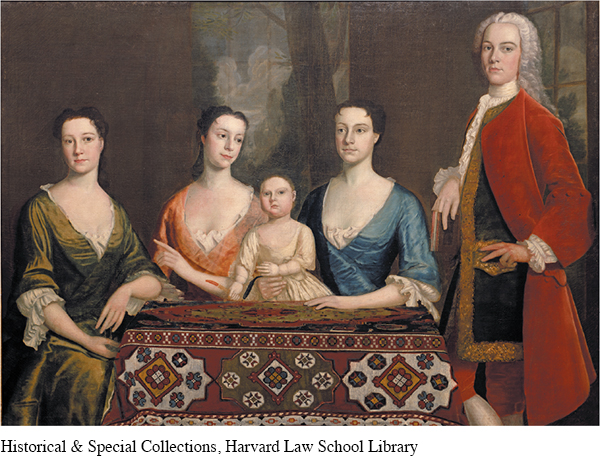Comparative Analysis Elite Women’s Lives in the North American Colonies Documents 4.2 and 4.3
COMPARATIVE ANALYSIS
Elite Women’s Lives in the North American Colonies
By the 1740s, elite women were viewed as paragons of piety and domesticity. Yet many contributed wealth and management skills to family enterprises. The painting by Robert Feke (Document 4.2) portrays Isaac Royall of Medford, Massachusetts, with his wife, Elizabeth, and his daughter, sister, and sister-in-law. Isaac’s estate was built on his deceased father’s trade in rum, sugar, and slaves from Antigua. Elizabeth cared for the family and its staff, including several slaves. In Document 4.3, twenty-year-old Eliza Lucas, born on Antigua, describes her typical routine. Although young and single, she managed her father’s South Carolina plantations, adding substantially to the family’s wealth.
Document 4.2
Isaac Royall and His Family, 1741

Document 4.3
Eliza Lucas | Letter to Miss Bartlett, London, c. 1742
Why, my dear Miss B, will you so often repeate your desire to know how I triffle away my time. . . . [H]ere it is.
In general then I rise at five o’Clock in the morning, read till Seven, then take a walk in the garden or field, see that the Servants [slaves] are at their respective business, then to breakfast. The first hour after breakfast is spent at my musick, the next is constantly employed in recolecting something I have learned least . . . , such as French and short hand. . . . I devote the rest of the time till I dress for dinner to our little Polly and two black girls who I teach to read, and if I have my papa’s approbation (my Mamas I have got) I intend [them] for school mistres’s for the rest of the Negroe children. . . . [After dinner, musick and then] the rest of the afternoon in Needle work till candle light, and from that time to bed read or write. . . . I have particular matter for particular days. . . . Mondays my musick Master is here. Tuesday my friend Mrs. Chardon (about 3 miles distant) and I are constantly engaged to each other, she at our house one Tuesday—I at hers the next, and this is one of the happiest days I spend at Woppoe. Thursday the whole day . . . is spent in writing, either on the business of the plantation, or letters to my friends. Every other Fryday . . . we go a vizeting so that I go abroad once a week and no oftener. . . .
O! I had like to forgot the last thing I have done a great while. I have planted a large figg orchard with design to dry and export them. . . . [W]as I to tell you how great an Estate I am to make this way . . . you would think me far gone in romance.
Source: Eliza Lucas Pinckney Letterbook, 1739–1762, South Carolina Historical Society.
Interpret the Evidence
What do the positions of the Royall family members, their clothing, and the furnishings indicate about the family’s and the women’s status?
How does Eliza Lucas’s description of her activities compare with those you imagine the Royall women perform? In what ways do these sources reflect or challenge patriarchal ideals?
Put It in Context
How did the profits of slavery and the slave trade shape the lives of elite women in northern and southern colonies?
Exploring American HistoriesPrinted Page 111
Chapter Timeline